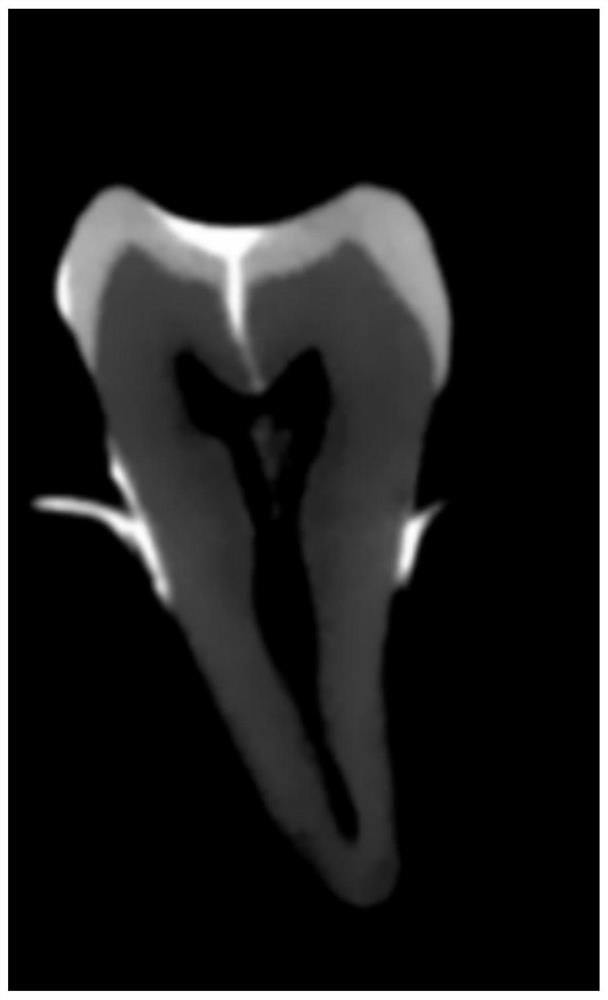Composite cone beam CT enhanced contrast agent and preparation method thereof
A configuration method and cone beam technology, applied in the field of oral and maxillofacial medical imaging, can solve problems such as troubles, and achieve the effect of improving the development rate and depth of development
- Summary
- Abstract
- Description
- Claims
- Application Information
AI Technical Summary
Problems solved by technology
Method used
Image
Examples
Embodiment 1
[0025] Such as figure 1 and figure 2 As shown, a composite cone beam CT enhanced contrast agent, including: X-ray imaging agent sodium iodide, distilled water, hydrophilic pharmaceutical penetrant dimethyl sulfoxide, organic solvent and bacteriolytic agent ethanol, lipophilic Penetrant and flavoring agent ethyl acetate.
[0026] A compound cone-beam CT enhanced contrast agent configuration method, comprising the following steps:
[0027] First, slowly dissolve 25 grams of 99% dimethyl sulfoxide in 10 g of distilled water, stir and dissolve to a homogeneous solution, then add 10 grams of 99% ethanol, stir and dissolve to a homogeneous solution, then add 99% ethyl acetate 10 g, stirred to a homogeneous solution; finally, 30 g of 99% sodium iodide was added to dissolve to a homogeneous solution to obtain a composite cone-beam CT enhanced contrast agent that can be used in the diagnosis of cracked teeth in vivo.
[0028] In order to clearly understand the contrast effect of th...
Embodiment 2
[0031] Such as image 3 As shown, first slowly dissolve 25 grams of 99% dimethyl sulfoxide in 10 g of distilled water, stir and dissolve to a homogeneous solution, then add 10 grams of 99% ethanol, stir and dissolve to a homogeneous solution, and finally add 99% 10 grams of ethyl acetate, stirred to a homogeneous solution; finally a composite CT enhanced contrast agent that can be used for the diagnosis of cracked teeth in vivo is obtained.
[0032] Use a soft-bristled brush to pick up the composite CT-enhanced contrast agent, apply it on the surface of the cracked tooth extracted in vivo, and wait for 1 hour. After the contrast agent penetrates into the crack, perform a CBCT scan to determine whether the crown is present. Cracks and crack depths.
Embodiment 3
[0034] Such as Figure 4-Figure 6 As shown, first 35 grams of 99% sodium iodide are dissolved in 25 grams of 99% dimethyl sulfoxide, stirred and dissolved to a homogeneous solution, then 10 grams of 99% ethanol is added, stirred and dissolved to a homogeneous solution, Finally, 10 grams of 99% ethyl acetate was added and stirred until a homogeneous solution was obtained; finally, a composite CT enhanced contrast agent that can be used for in vivo cracked tooth diagnosis was obtained.
[0035] Collect the longitudinally fractured teeth extracted in vivo, remove the filling in the pulp cavity, use a dropper with a capacity of 1.8ml to absorb the contrast medium, and drop the contrast medium into the pulp cavity, wait for 15 minutes, and wait for the contrast medium to penetrate After entering the crack, a CBCT scan is performed to determine whether there is a crack in the tooth root.
[0036] Depend on figure 1 It can be seen that the hidden cracks under the body condition are...
PUM
 Login to View More
Login to View More Abstract
Description
Claims
Application Information
 Login to View More
Login to View More - R&D
- Intellectual Property
- Life Sciences
- Materials
- Tech Scout
- Unparalleled Data Quality
- Higher Quality Content
- 60% Fewer Hallucinations
Browse by: Latest US Patents, China's latest patents, Technical Efficacy Thesaurus, Application Domain, Technology Topic, Popular Technical Reports.
© 2025 PatSnap. All rights reserved.Legal|Privacy policy|Modern Slavery Act Transparency Statement|Sitemap|About US| Contact US: help@patsnap.com



